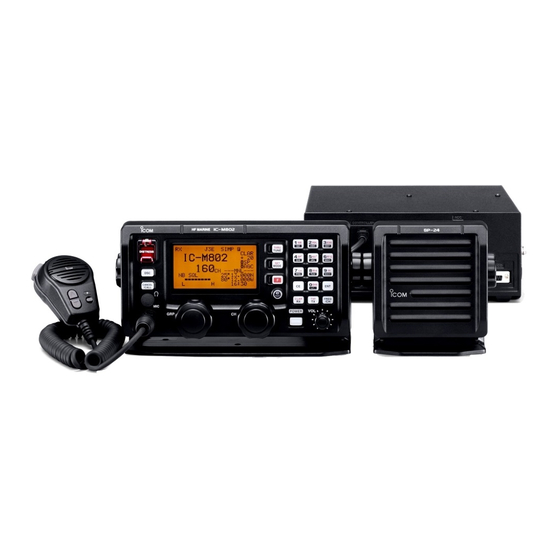
Advertisement
Quick Links
Icom America
04/27/07
M802 Channels
HF Marine Transceiver
Your new Icom M802 has 160 user programmable marine channels in addition to the
ITU channels, most of which have been preprogrammed by Icom America. These
channels have been programmed to best reflect the needs of boaters throughout the
United States. These user channels can be reprogrammed by you, the user. A list of
the preprogrammed channels is included. Also included is a procedure you can use to
reprogram these channels to best reflect your operating needs, as well as an article
explaining SSB channels and frequencies.
1
Advertisement

Summary of Contents for Icom M802
- Page 1 M802 Channels HF Marine Transceiver Your new Icom M802 has 160 user programmable marine channels in addition to the ITU channels, most of which have been preprogrammed by Icom America. These channels have been programmed to best reflect the needs of boaters throughout the United States.
- Page 4 Table A: User Channels Ship Receive Channel Transmit MODE Comment N°. Freq. Name Freq. 2182.0 2182.0 Distress LOCAL DISTRESS (Intl Ch) 4125.0 4125.0 SOS 4S DISTRESS CALLS 6215.0 6215.0 SOS 6S DISTRESS CALLS 8291.0 8291.0 SOS 8S DISTRESS CALLS 12290.0 12290.0 SOS 12S DISTRESS CALLS...
- Page 5 Ship Receive Channel Transmit MODE Comment N°. Freq. Name Freq. Weather 2054.0 WXFX AK Weather Fax Kodiak, Alaska Charts Weather 4298.0 WXFX AK Weather Fax Kodiak, Alaska Charts Weather 8459.0 WXFX AK Weather Fax Kodiak, Alaska Charts Weather 12412.5 WXFX AK Weather Fax Kodiak, Alaska Charts Weather...
- Page 6 Ship Receive Channel Transmit MODE Comment N°. Freq. Name Freq. 5975.0 Receive Only BBC 5 BBC World Service News 11835.0 Receive Only BBC 11 BBC World Service News 15190.0 Receive Only BBC 15 BBC World Service News 9755.0 Receive Only CBC NEWS CBC Radio Canada News 15290.0...
- Page 7 Ship Receive Channel Transmit MODE Comment N°. Freq. Name Freq. 8122.0 8122.0 AMIGO Amigo Net (Don's Wx) 8125.0 8125.0 S-S 8125 8 MHz Ship-to-Ship 8131.0 8131.0 S-S 8131 8 MHz Ship-to-Ship 8137.0 8137.0 CARIB WX Caribbean WX Center Net 8152.0 8152.0 CRUZHIMR Cruzheimers Net Summer...
- Page 8 Ship Receive Channel Transmit MODE Comment N°. Freq. Name Freq. 7238.0 7238.0 BAJA 723 Baja Calif. Net 7250.0 7250.0 GORDO Gordo Net 7260.0 7260.0 BAJA 723 Baja Calif. Net 7268.0 7268.0 EC WW 72 EC Waterway Net 7270.0 7270.0 S ATLNTC South Atlantic Net 7285.0 7285.0...
- Page 9 UNDERSTANDING YOUR SSB CHANNELS AND FREQUENCIES By Gordon West, CMET Of the nearly 1000 SSB channels pre-stored in your SSB radio, only a hundred or so can actually lead to meaningful reception. Those “hot 100” channels are likely pre-loaded in user programmable memory (UPM), and Gordo explains how to dial in these most-important frequencies….
- Page 10 Here is a simple formula to figure an approximate range of reception. MHz x 100 = expected minimum range MHz x 200 = expected maximum range Marine SSB channels, and their approximate range, are listed here: 2 MHz 0-200 miles very short range, local 4 MHz 400-800 miles...
- Page 11 transmission and reception near Seattle (KLB), that can receive SSB transmissions from subscribers sailing the Atlantic and Pacific Oceans north of the equator and connect them with any telephone in the world. SIMPLEX ITU channels have been “split” to offer ship-to-ship and ship- to-shore communications.
- Page 12 LOGICAL USER CHANNELS SSB Manufacturer ICOM, with their flagship radios the M-802 and M- 710, realized the frustrating confusion arising from the huge number of channels available, where they all fit, and who needs which frequencies when cruising to far off places. A list of the top 160 USER CHANNELS was recently developed by marine radio experts coast-to- coast, and compiled by Rick Waedekin, Sr., ICOM America technical...
- Page 13 Channel 1: 2182 kHz This is an ultra short range distress channel likely to have no further range than VHF Channel 16. Channels 2-6: These are simplex distress channels monitored continuously by our US Coast Guard at various locations throughout the country.
- Page 14 Channels 35-61: These are your weather facsimile frequencies. “PAC” is for Pacific coverage, “ATL” for the Atlantic, “GUL” for the Gulf. Alaska is “AK” and Hawaii is “HI”. These are not continuous weather fax signals, but at least 4 times a day you should hear activity for up to an hour.
- Page 15 could allow you to talk thousands of miles away at sea to other boats, or to your local yacht club if they have the marine SSB station license. Ship-to-ship channels labeled with “A”, “B”, and “C” are primary racing channels, in regular use by long range cruising mariners, as well as race committees.
- Page 16 Ham radio channels, pre-loaded in your marine SSB allow you to LISTEN and glean valuable weather information. The powerful shore- side net control stations are easily heard over hundreds, perhaps thousands of miles, giving out great weather forecasts and taking reports from licensed ham operators from around the country -- sometimes from around the world.
- Page 17 WHERE ARE THESE CHANNELS? To take advantage of these pre-memorized user channels, you first need to find where the user channels have been stored in YOUR marine SSB. Try this: On your keypad, type 1-0-0 ENT. You should be in the middle of the user channel set, at user channel 100. Next, verify that YOUR user channels are similar to those in table A.
- Page 18 FCC Rule Part 80.13(b) requires all marine SSB installations to be licensed with call letters. Please contact Radio School at 714 549 5000 Monday to Thursday 10AM-4PM for info and/or assistance with licensing. For ham radio licensing information please contact Radio School at 714 549 5000 Monday to Thursday 10AM-4PM.












Need help?
Do you have a question about the M802 and is the answer not in the manual?
Questions and answers